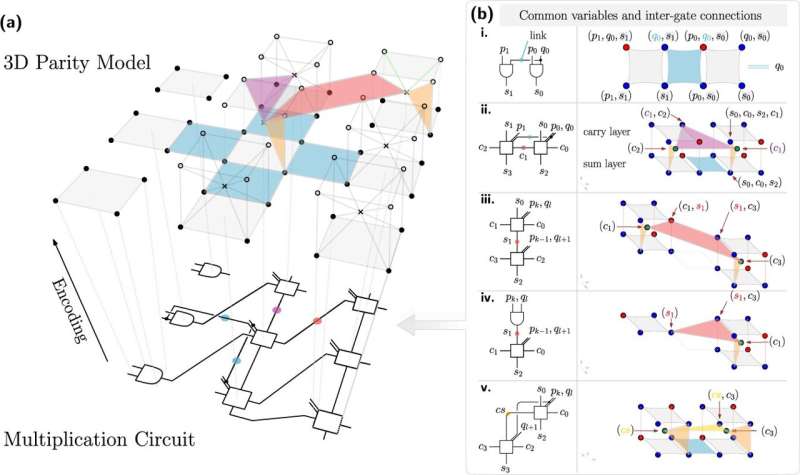This article has been reviewed according to Science X's editorial process and policies. Editors have highlighted the following attributes while ensuring the content's credibility:
fact-checked
peer-reviewed publication
trusted source
proofread
A blueprint for a quantum computer in reverse gear

Large numbers can only be factorized with a great deal of computational effort. Physicists at the University of Innsbruck, Austria, led by Wolfgang Lechner are now providing a blueprint for a new type of quantum computer to solve the factorization problem, which is a cornerstone of modern cryptography. The research was recently published in Communications Physics.
Today's computers are based on microprocessors that execute so-called gates. A gate can, for example, be an AND operation, i.e., an operation that adds two bits. These gates, and thus computers, are irreversible. That is, algorithms cannot simply run backwards. "If you take the multiplication 2x2=4, you cannot simply run this operation in reverse, because 4 could be 2x2, but likewise 1x4 or 4x1," explains Wolfgang Lechner, professor of theoretical physics at the University of Innsbruck. If this were possible, however, it would be feasible to factorize large numbers, i.e., divide them into their factors.
Martin Lanthaler, Ben Niehoff and Wolfgang Lechner from the Institut für Theoretische Physik at the University of Innsbruck and the quantum spin-off ParityQC have now developed exactly this inversion of algorithms with the help of quantum computers. The starting point is a classical logic circuit, which multiplies two numbers. If two integers are entered as the input value, the circuit returns their product. Such a circuit is built from irreversible operations. "However, the logic of the circuit can be encoded within ground states of a quantum system," explains Martin Lanthaler from Wolfgang Lechner's team. "Thus, both multiplication and factorization can be understood as ground-state problems and solved using quantum optimization methods."
Superposition of all possible results
"The core of our work is the encoding of the basic building blocks of the multiplier circuit, specifically AND gates, half and full adders with the parity architecture as the ground state problem on an ensemble of interacting spins," says Martin Lanthaler.
The coding allows the entire circuit to be built from repeating subsystems that can be arranged on a two-dimensional grid. By stringing several of these subsystems together, larger problem instances can be realized. Instead of the classical brute force method, where all possible factors are tested, quantum methods can speed up the search process: To find the ground state, and thus solve an optimization problem, it is not necessary to search the whole energy landscape, but deeper valleys can be reached by "tunneling."
The current research work provides a blueprint for a new type of quantum computer to solve the factorization problem, a cornerstone of modern cryptography. This blueprint is based on the parity architecture developed at the University of Innsbruck and can be implemented on all current quantum computing platforms.
More information: Martin Lanthaler et al, Scalable set of reversible parity gates for integer factorization, Communications Physics (2023). DOI: 10.1038/s42005-023-01191-3
Journal information: Communications Physics
Provided by University of Innsbruck





















